ISSN ONLINE(2319-8753)PRINT(2347-6710)
ISSN ONLINE(2319-8753)PRINT(2347-6710)
Mrs. V. S. Dhongde1, Prof. M. R. Wargantwar2, Mrs. S.G.Joshi2
|
| Related article at Pubmed, Scholar Google |
Visit for more related articles at International Journal of Innovative Research in Science, Engineering and Technology
Biometric identification system employs physiological or behavioural characteristics to accurately identify each subject. The most reliable biometric system is the iris recognition due to richness and stability of iris texture. In this paper we proposed the cumulative sum based change analysis and neural network. The performance evaluation was measured in terms of false rejection rate and false acceptance rate. The experimental result gives the comparison between different methods and shows that neural network is a promising and effective approach in iris recognition
Keywords |
| Iris recognition, Hough transforms, Neural Network |
INTRODUCTION |
| Now a day’s every one possesses different types of cards for example- ATM card, Driving license, VISA card or student of college also possesses identity card, library card. For this every one need to remember number of passwords, also to carry proofs and cards. Only the reason behind is that, every wants to secure his data/information. The solution to this problem is that we need such a system which operates automatically and does not require to carry card like devices and also to remember password. All these requirements will be fulfil by biometric identification system. Biometric system provides automatic recognition of individual based on some fingerprints, facial features, voice, hand geometry, handwriting, the retina, and the one presented in paper is the iris. Biometric system work by first capturing a sample of the feature. The sample is then transformed using some sort of mathematical function into a biometric template. The biometric template will provide a normalized, efficient and highly discriminating representation of the feature, which can then be compared with other templates in order to determine identity. Many studies have been previously presented. [1] Proposed a phase demodulation method for iris feature extraction. An iris image is encoded into a compact sequence of multi scale quadrature 2-D Gabor wavelet coefficients, whose most significant bits compromise a 256-byte iris code. [2] Gives a zero crossing representation of one dimensional wavelet transform, calculated to characterise the texture of the iris. In [3], a texture analysis approach was proposed. A multi channel Gabor filtering was used to capture global and local details in an iris image. In [4] independent component analysis for iris pattern analysis has been used. |
IRIS RECOGNITION SYSTEM |
| The Iris is an externally visible and well protected organ whose unique epigenetic attractive pattern remains stable throughout the adult life. These characteristics make it very attractive for use as biometric identifying individuals. Image processing technique can be employed to extract the unique iris pattern from a digitized image of eye, and encode it in to biometric template contains an objective mathematical representation of unique information stored in iris, and allows comparison to be made between templates. When a subject wishes to be identified by iris recognition system, their eye is first photographed and then a template created for their iris region. This template is then compared with other templates stored in database until either a matching template is found and the subject is identified or no match is found and the subject remains undefined. Thus the basis of every biometric is to get the input signal/image apply some algorithm and extract the prominent feature for person identification /verification. In the identification case, the system is trained with the patterns of several persons. For each person, a template is calculated in training stage. A pattern that is going to be identified is matched against every known template. In the verification case, a person’s identity is claimed. The pattern that is verified only is compared with the person’s individual template. Most biometric systems allow two modes of operation, an enrolment mode for adding templates to database, and an identification mode, where a template is created for an individual and then a match is searched for in the database of pre-enrolled templates. An easy way to comply with the conference paper formatting requirements is to use this document as a template and simply type your text into it. |
| A. System Development |
| In general a biometric system consists of following components: pre-processing algorithms that remove artifacts from the digital output. These algorithms usually enhance, segment, normalize the digital images; a feature extractor that extracts significant features; a template generator that generates a biometric template which provides a discriminating representation of features; a storage component or the database that stores templates; and a classifier. A classifier compares the generated template with the other stored templates for recognition. The iris region can be approximated by two circles, one for the iris/sclera boundary and another, interior to first, for the iris/pupil boundary. The eyelids and eyelashes normally occlude the upper and lower parts of the iris region. |
| 1) Iris Segmentation: |
| In the pre-processing stage iris segmentation and normalization was done. During the segmentation iris region is isolated in an eye image by eliminating eyelids, eyelashes. The segmented iris region is normalized using Daugman’s rubber sheet model in the normalization stage. In pupil detection, the iris image is converted into grayscale to remove the effect of illumination. As pupil is the largest black area in the intensity image, its edges can be detected easily from the binarized image by using suitable threshold on the intensity image. Thus the first step to find or separate out the pupil apply histogram of input image from which we get threshold value for pupil, then apply edge detection, once edge of pupil find , then center coordinates and radius can be easily find out by following algorithm and code – |
| 1. Find the largest and smallest values for both x and y axis. |
| 2. Add the two x-axis value and divide them by two will gives x- center point. |
| 3. Similarly add two y-axis values, divide it by two, gives y- center point. |
| 4. Radius is calculated by subtracting minimum value from maximum and divides it by two gives the radius of pupil circle. |
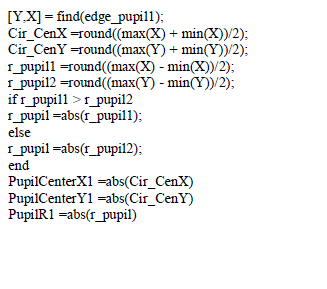 |
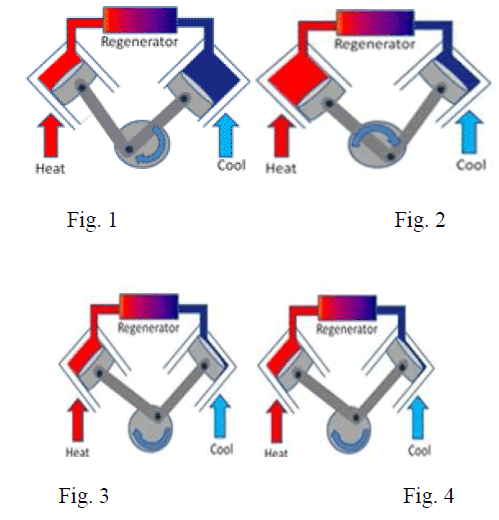 |
 |
| Step 2. Divide normalized iris image into basic cell region. One cell region equals to 3(row) X 10 (column) pixel size. |
| Step 3. Represent each cell by their average grey value as a representative of respective cell. |
| Step 4. Make the group of average values obtained [1X5]. |
| Step 5. Calculate cumulative sums over each group. |
| Features are extracted [Vertically] as follows- |
| Step1. Take the transpose of normalized image matrix which becomes 150(rows) X 36(columns) pixel size. |
| Step2. Divide normalized image matrix into basic cell region. One cell region equals to10 (row) X 3 (column) pixel size. |
| Step3. Represent each cell by their average grey value as a representative of respective cell. |
| Step 4. Make the group of average values obtained [1X3]. |
| Step 5. Calculate cumulative sums over each group. |
| This will gives the two matrixes in which each element indicates cumulative sum value. For horizontal process 12 X 15 and for vertical process 15 X 12 matrixes will obtain. The procedure to calculate cumulative sum is described as follows-suppose that X1, X2, X3, X4, X5 are five representative values of each cell region within the first group located on the left top corner of figure 3.10. Then cumulative sums are calculated in the following way. Step 1. Calculate the average Xm=(X1+X2+X3+X4+X5))/5 |
| Step 2. Calculate cumulative sum from 0:S0 = 0 |
| Step 3.Calculate the other cumulative sums by adding the difference between the current value and the average to the previous sum: |
| Si = Si-1 + ( Xi – X) for i= 1,2,3,4,5 |
| The next step is to generate the code which is generated by using simple algorithm given below- |
| Step 1. First calculate the maximum and minimum value from the obtained group cumulative sum. |
| Step 2. If Si located between MAX and MIN index and if Si is on upward slope set cell’s iris code to 1 and if Si is on downward slope set cell’s iris code to 2. |
| Step 3. If Si is not located in between MAX and MIN set the iris code to 0. |
| This algorithm generates iris codes by analyzing cumulative sums which describe the variations in the grey values of iris patterns. An upward slope of cumulative sums means that the iris pattern may change from darkness to brightness. A downward slope of cumulative sums means the opposite. An example of iris code generation is shown in fig.5. Each cell has two iris codes: one for horizontal direction, the other for vertical. |
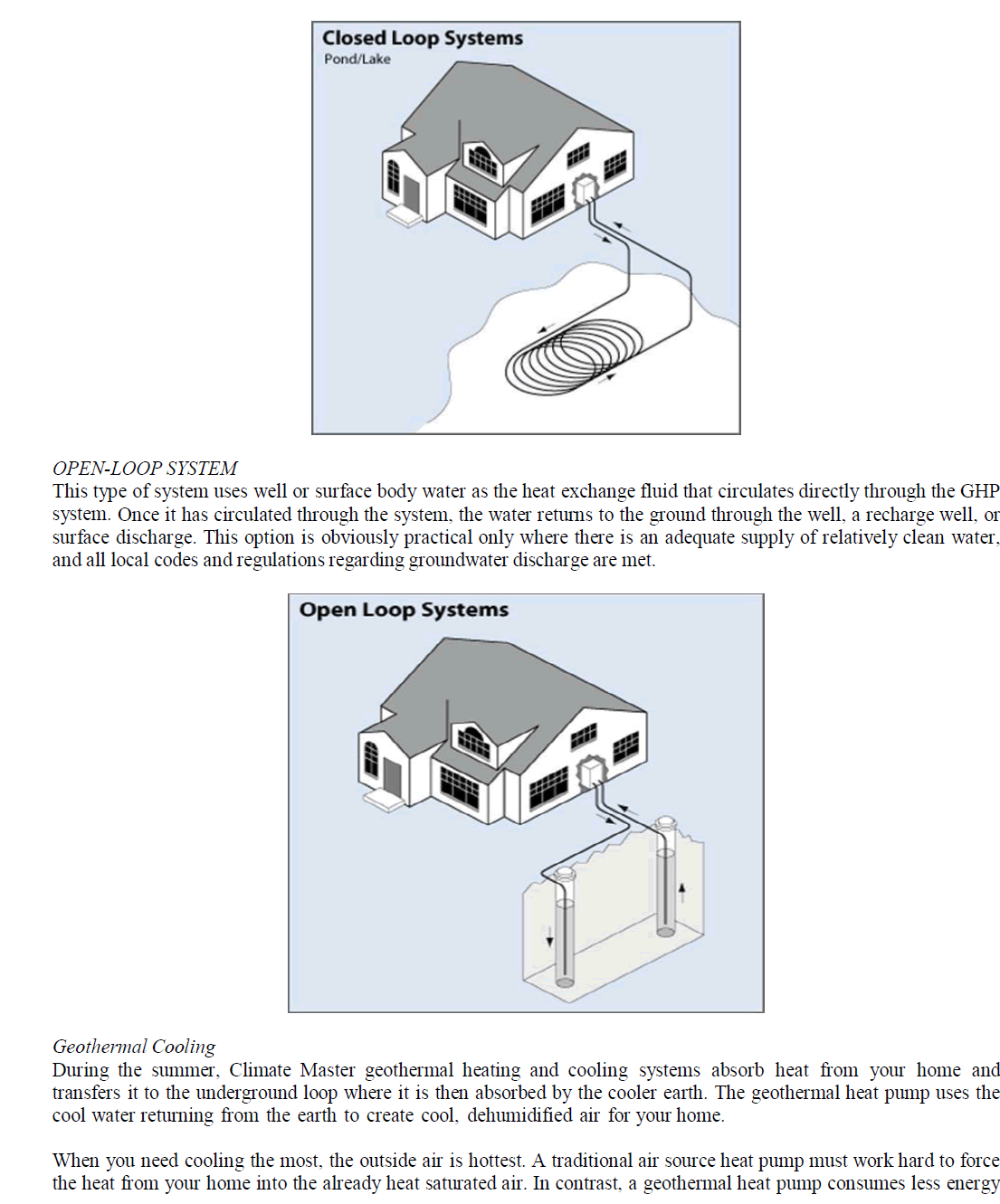 |
 |
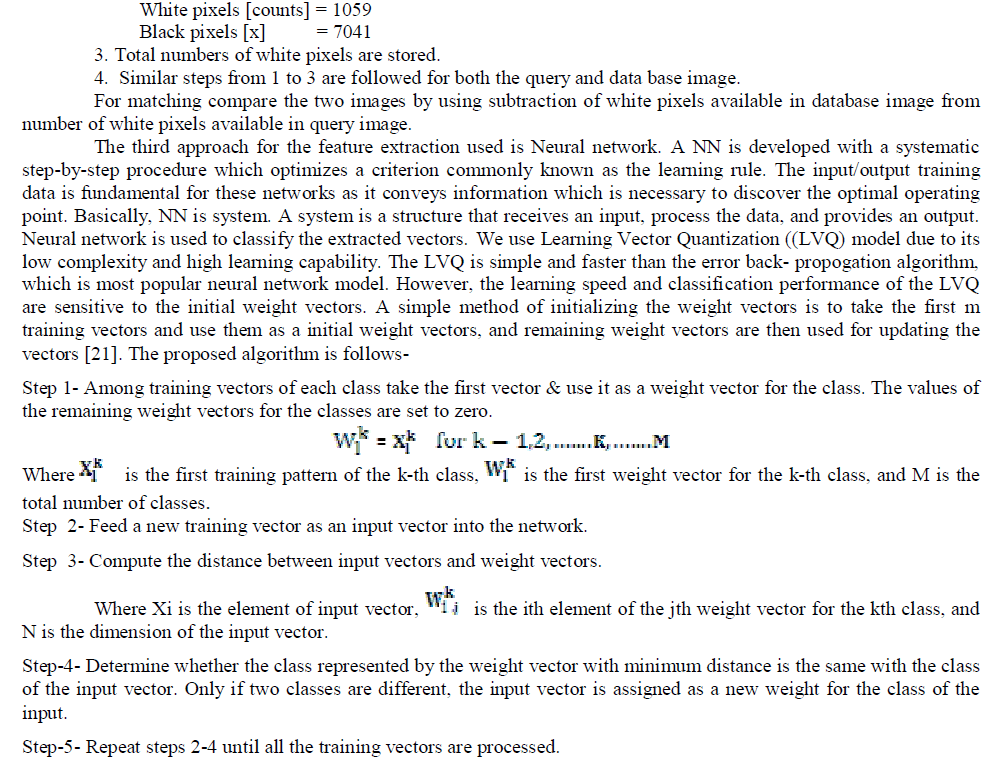 |
MATCHING |
| In order to provide accurate recognition of individuals, the most discriminating information present in an iris pattern must be extracted. Only the significant features of the iris must be encoded so that comparisons between templates can be made. The template that is generated in the feature encoding process will also need a corresponding matching metric, which gives a measure of similarity between two iris templates. This metric should give one range of values when comparing templates generated from the same eye, known as intra-class comparisons, and another range of values when comparing templates created from different irises, known as inter-class comparisons. The two metrics that is used are explained in brief below. |
| A. Hamming distance : |
| The Hamming Distance gives a measure of how many bits are the same between two bit patterns . Using the Hamming Distance of two bit patterns, a decision can be made as to whether the two patterns were generated from different irises or from the same one. In comparing the bit patterns X and Y, the Hamming Distance, HD, is defined as the sum of disagreeing bits (sum of the exclusive-OR between X and Y) over N, the total number of the bit pattern. |
| A. Euclidean distance (ED): |
| The Euclidean Distance (ED) can be used to compare two templates, especially if the template is composed of integer values. The weighting Euclidean distance gives a measure of how similar a collection of values are between two templates. The Euclidean distance metric is a classically used means of measuring the distance between 2 vectors of n elements. |
PERFORMANCE ANALYSIS |
| The most commonly used metric for matching the two bit strings generated by query image and template stored in database is the Hamming Distance. It is a simple XOR operation where result equal to zero when both said a string has same bit string. Euclidean distance is especially useful for comparing matching whole word object elements of two vectors. It measures only distance between two iris code vectors. The figure 9 to 11 shows the obtained result - |
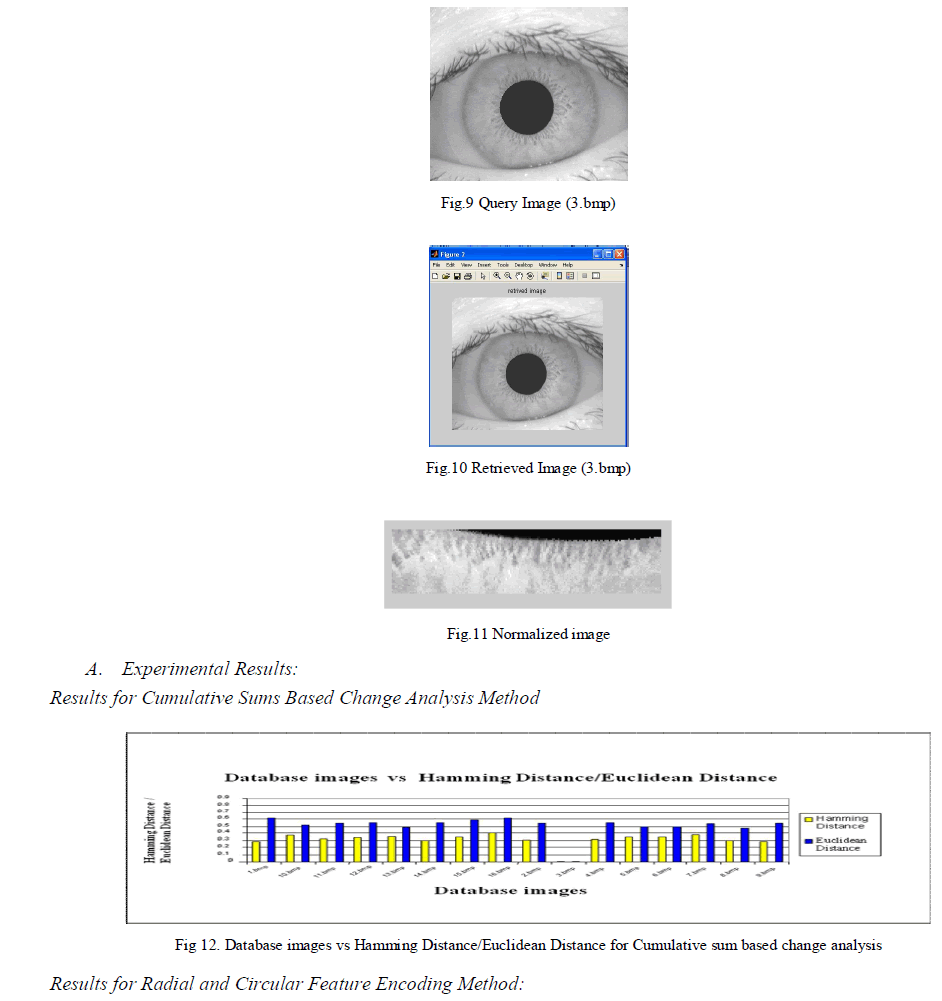 |
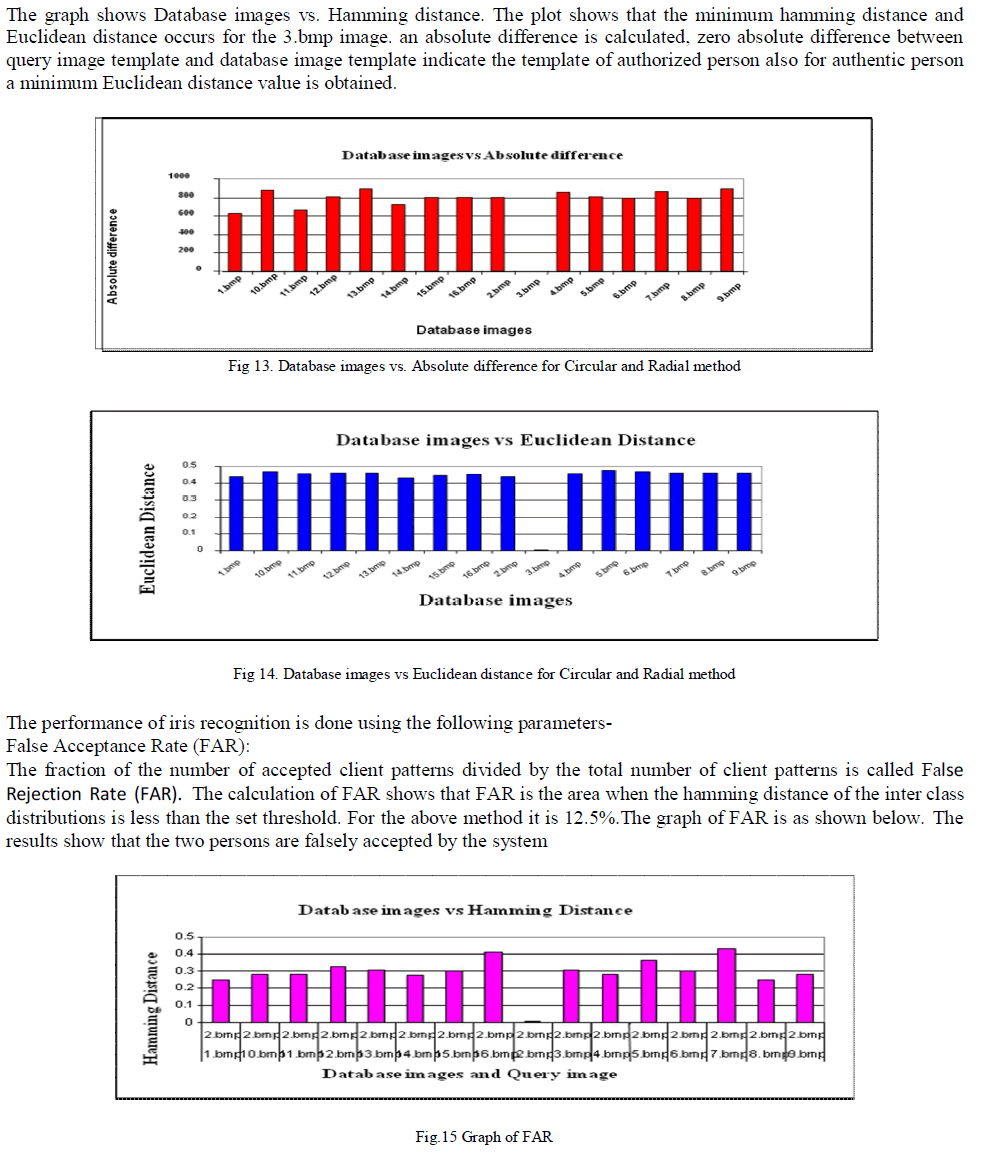 |
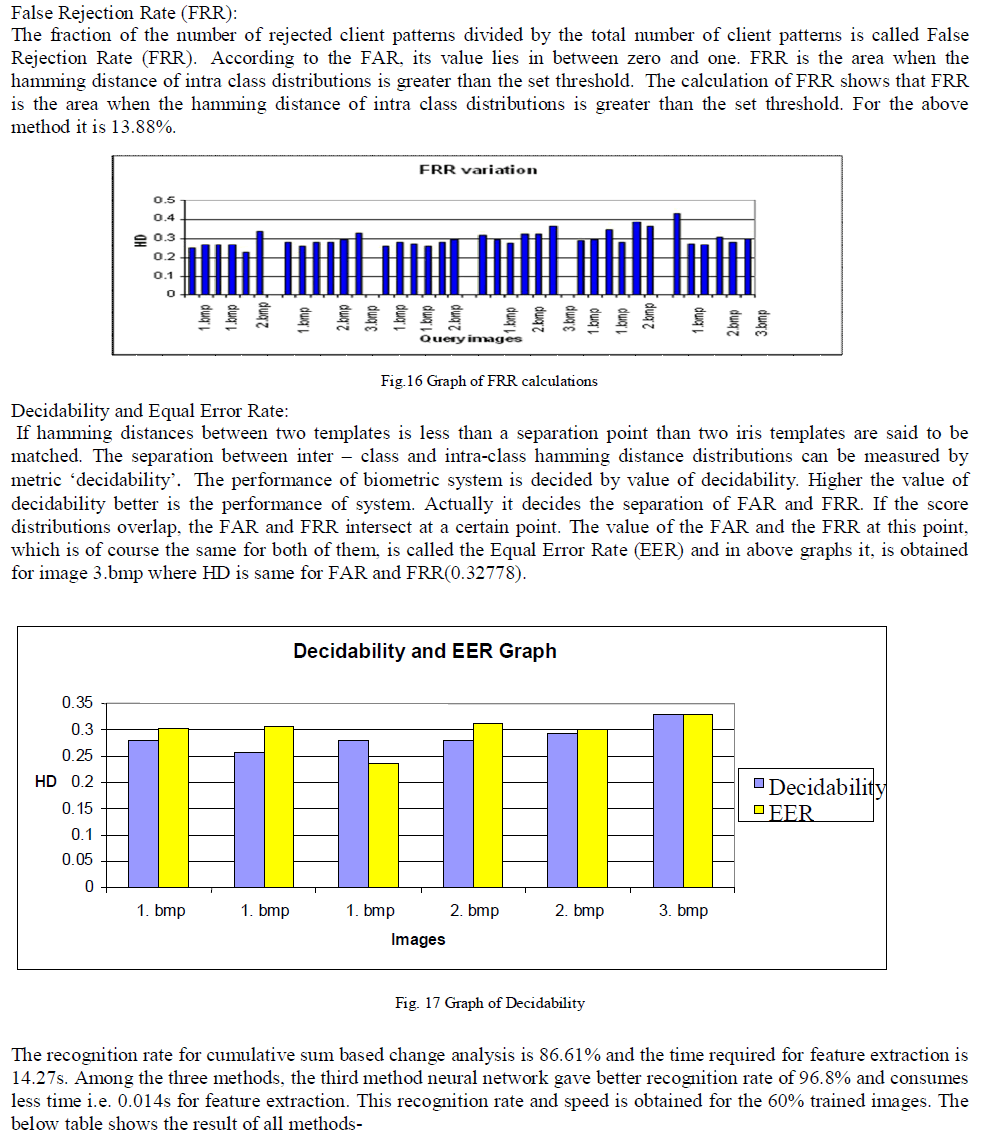 |
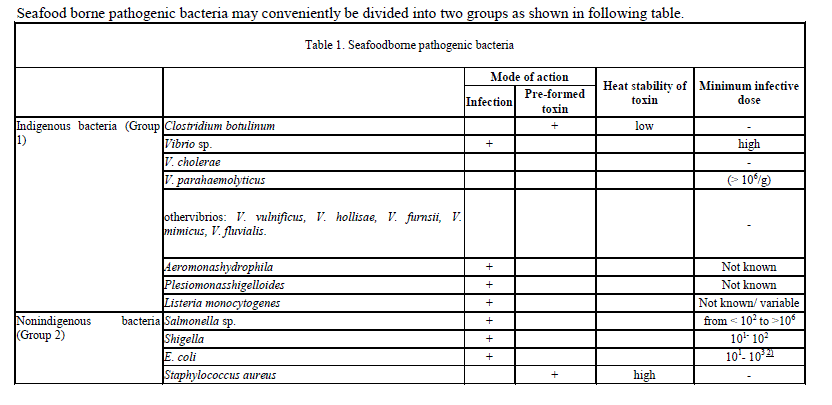 |
| Table I Recognition of performance comparing with existing methods |
CONCLUSIONS and FUTURE SCOPE |
| In the Cumulative sum based change analysis feature extraction method, a normalized iris image is divided into cells and codes generated for these cells by the proposed code generation algorithm. The method is relatively simple and efficient compared to other existing methods. The recognition rate for cumulative sum based change analysis is 86.61% and the time required for feature extraction is 14.27s. In the next method the features are extracted by using Radial and Circular feature extraction method. The Performance of this algorithm is not encouraging. As the inter-class hamming distance distribution is almost overlapping with intra-class hamming distance distribution. It is very hard to find good separation point for this algorithm. Also this algorithm is based on result of edge detection and edge detection algorithms are not efficient for illumination in images. Some edges cannot be detected if image is taken in low illumination condition. This algorithm did not give better verification results. The neural network is another method which is used for personal iris recognition system. Using this method, iris segmentation is performed in short time. The located iris after pre-processing is represented by a feature vector. Using this vector as input signal the neural network is used to recognize the iris patterns. Among the three methods, the third method neural network gave better recognition rate of 96.8% and consumes less time i.e. 0.014s for feature extraction. Hamming distance is chosen as a classifier, which calculates the similarity between two iris codes. A lower hamming distance indicates higher similarity and the two templates were deemed to be generated from the same iris. The image 3.bmp has obtained the minimum Hamming distance and Euclidean distance. The Hamming distance for 3.bmp is 0.05 and Euclidean distance is 0.011.Therefore the test image belongs to the 3rd person. From all the future extraction method it is observed that the neural network gave the better result and the feature execution time is very less. So, among the three methods neural network is one of the better recognition systems. |
ACKNOWLEDGMENT |
| I would like to thank all those who have contributed to the completion of the project report and helped me with valuable suggestion for improvement. Special thanks to Prof. M. R.Wargantwar, MIT, Aurangabad for her valuable guidance for the project. |
References |
|